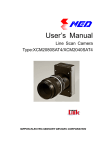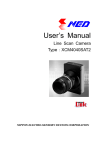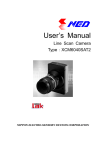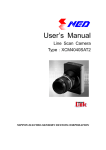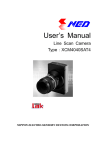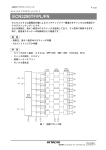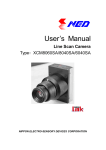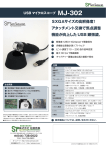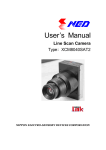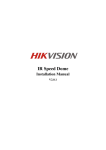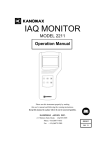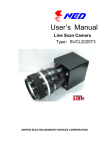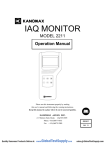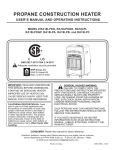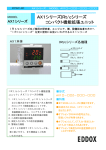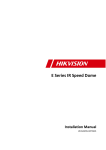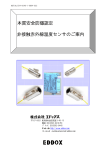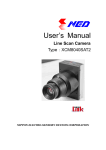Download Product Manual
Transcript
User’s Manual
Line Scan Camera
Type: XCM2040SAT2
NIPPON ELECTRO-SENSORY DEVICES CORPORATION
2
NED
For Customers in the U.S.A.
This equipment has been tested and found to comply with the limits for a Class A
digital device, in accordance with Part 15 of the FCC Rules. These limits are designed to
provide reasonable protection against harmful interference when the equipment is
operated in a commercial environment. This equipment generates, uses, and can radiate
radio frequency energy and, if not installed and used in accordance with the instruction
manual, may cause harmful interference to radio communications. Operation of this
equipment in a residential area is likely to cause harmful interference, in which case the
user will be required to correct the interference at his or her own expense.
For Customers in the EU
This equipment has been tested and found to comply with the essential requirements
of the EMC Directive 2004/108/EC, based on the following specifications applied:
EU Harmonized Standards
EN55022:2006+A1:2007 Class A
EN61000-6-2:2005
Warning
This is a class A product. In a domestic environment this product may cause radio
interference in which case the user may be required to take adequate measures.
Directive on Waste Electrical and Electronic Equipment (WEEE)
Please return all End of Life NED products to the distributor from whom the product was
purchased for adequate recycling and / or disposal. All costs of returning the Product to
NED are borne by the shipper.
XCM2040SAT2
UME-0011-02
3
NED
Introduction
Thank you for purchasing NED’s Line Scan Camera. We look forward to your
continued custom in the future.
For safety use
For your protection, please read these safety instructions completely before
operating the product and keep this manual for future reference.
The following symbols appear next to important information regarding safe product
handling.
Warning
If the product is not handled properly, this may result
in serious injury or possible death.
Caution
If the product is not handled properly, this may result
in physical injury or cause property damage.
Safety precaution
Warning
Never disassemble or modify this product, unless otherwise specified to do so in this
manual.
When hands are wet, avoid handling this product and do not touch any of the
connection cable pins or other metallic components.
Do not operate this product in an environment that is exposed to rain or other severe
external elements, hazardous gases or chemicals.
If the product is not to be used for an extended period of time, as a safety precaution,
always unplug the connection cable from the camera unit.
If the product installation or inspection must be executed in an overhead location,
please take the necessary measures to prevent the camera unit and its components
from accidentally falling to the ground.
If smoke, an abnormal odor or strange noise is emitted from the camera unit, first
turn OFF power, then unplug the cable from the camera unit.
This product is not intended for use in a system configuration built for critical
applications.
XCM2040SAT2
UME-0011-02
4
NED
Instructions before use
Only operate this product within the recommended environmental temperature
range.
Use only the specified power source and voltage rating.
Do not drop this product. Avoid exposure to strong impact and vibrations.
Install the camera unit in a well-ventilated environment, in order to prevent the
camera from overheating.
If the camera must be installed in an environment containing dust or other particles,
take required measures to protect the camera unit from dust adhesion.
Do not unplug the cable while power is being supplied to the camera unit. To prevent
product damage, always shut down the power supply before unplugging the power
cable.
When the surface of the camera window becomes dirty due to dust or grime, black
smudges appear in the displayed image. Use an air blower to remove the dust
particles. Dip a cotton swab into ethanol alcohol and clean the camera window. Be
careful not to scratch the glass.
Use of non-infrared lighting such as a fluorescent lamp is recommended. If halogen
lighting is employed, always install an infrared filter into your system configuration.
Please note that exposure to long wavelength light outside of the sensors visible
optical range can affect the image.
Sensitivity may fluctuate depending on the spectral response level of the light source.
In cases like this, changing the light source to one with a different spectral response
level may reduce this problem.
For stabilized image capturing, turn ON the power supply and execute aging for ten
to twenty minutes before actually using the camera unit.
Do not share the power supply with motor units or other devices that generate noise
interference.
The signal ground (SG) and the frame ground (FG) are connected inside the camera
unit. Design the system configuration so that a loop will not be formed by the ground
potential differential.
Do not disconnect the camera while rewriting an embedded memory.
When you change exposure mode that is set at NED factory, input control signal
(CC1) from the capture board.
XCM2040SAT2
UME-0011-02
5
NED
Exclusion Clause
The manufacturer assumes no responsibility for damages resulting from natural
disasters, earthquakes, or acts executed by a third party. Warranty excludes any
accidents resulting from improper handling or misuse of this product, whether
intentional or not, and any camera operations conducted under abnormal conditions.
The manufacturer assumes no responsibility for any incidental damages (loss of
corporate profits, interruption of business, etc.) resulting form use or non-use of this
product.
The manufacturer assumes no responsibility for damages resulting from failure to
follow the instructions and procedures indicated in this User’s Manual.
The manufacturer assumes no responsibility for any damages resulting from
malfunctions caused by combined use of this product with other peripheral
equipment.
The manufacturer assumes no responsibility for damages resulting from
malfunctions caused by non-authorized repair or modifications made to this product.
XCM2040SAT2
UME-0011-02
6
NED
Table of Contents
1 Product Outline ...................................................................... 9
1.1 Features(XCM2040SAT2).................................................................................................... 9
1.2 Application ............................................................................................................................... 9
1.3 Image Sensor ......................................................................................................................... 10
1.4 Performance Specifications.................................................................................................. 11
2 Camera Setting and Optical Interface ................................ 13
2.1 Setting the Camera ................................................................................................................ 13
2.2 Fixing the Camera.................................................................................................................. 13
2.3 Optical Interface..................................................................................................................... 16
3 Hardware............................................................................... 17
3.1 Camera Connection............................................................................................................... 17
3.2 Input / Output Connectors and Indicator............................................................................. 19
3.3 Connectors・Pin Assignments・Cables................................................................................. 20
3.4 Power Supply......................................................................................................................... 23
4 Camera Control .................................................................... 24
4.1 Flow of Camera Control ........................................................................................................ 24
4.1.1 Command Overview........................................................................................................ 24
4.1.2 Camera Receiving Message (PC Sending Command) ................................................. 24
4.1.3 Camera Sending Message (PC Receiving Message) ................................................... 25
4.1.4 Camera Control Commands........................................................................................... 26
4.1.5 Memory Setup Values (Factory Settings)...................................................................... 27
4.2 Details on Commands ........................................................................................................... 27
4.2.1 Setting Analog Gain ........................................................................................................ 27
4.2.2 Setting Digital Gain ......................................................................................................... 28
4.2.3 Setting Digital Offset....................................................................................................... 28
4.2.4 Setting Exposure Mode .................................................................................................. 28
4.2.5 Setting Exposure Time ................................................................................................... 29
4.2.6 Setting Output Signals (Setting Data Format) .............................................................. 29
4.2.7 Setting the Pixel Readout Direction .............................................................................. 29
4.2.8 Saving Pixel Correction Data ......................................................................................... 30
4.2.9 Setting Pixel Correction ................................................................................................. 30
XCM2040SAT2
UME-0011-02
7
NED
4.2.10 Generating Test Pattern................................................................................................ 30
4.2.11 Memory Initializing (Initializing Camera Settings) ...................................................... 31
4.2.12 Memory Load................................................................................................................. 32
4.2.13 Memory Save ................................................................................................................. 32
4.2.14 Returning the Camera Settings to the its original status........................................... 33
4.3 Digital Processing flow in FPGA .......................................................................................... 34
4.4 Startup .................................................................................................................................... 34
4.5 Saving and Loading Camera Settings ................................................................................. 35
4.6 Serial Communication Settings............................................................................................ 36
4.7 Video Output Format ............................................................................................................. 36
4.8 Exposure Mode and Timing Chart........................................................................................ 39
4.8.1 Free Run Exposure Mode (Programming time setting) ............................................... 39
4.8.2 External Trigger Exposure Mode (External trigger edge) ......................................... 40
4.8.3 External Trigger Exposure Mode (Trigger Level).......................................................... 41
4.9 Setting Offset ......................................................................................................................... 42
4.10 Setting Gain ......................................................................................................................... 43
4.11 Pixel Correction ................................................................................................................... 44
4.11.1 How to calibrate the camera......................................................................................... 45
4.12 Test Pattern .......................................................................................................................... 46
5 Confirming Camera Settings............................................... 50
5.1 Before Power-on .................................................................................................................... 50
5.2 After Power-on ....................................................................................................................... 51
5.3 In Operation ........................................................................................................................... 53
6 Sensor Handling Instructions ............................................. 54
6.1 Electrostatic Discharge and the Sensor .............................................................................. 54
6.2 Protecting Against Dust, Oil and Scratches........................................................................ 54
6.3 Cleaning the Sensor Window ............................................................................................... 54
7 Troubleshooting ................................................................... 55
7.1 When there is no Image ........................................................................................................ 55
7.2 When Noise is present in the Image .................................................................................... 57
7.3 When the Camera becomes hot ........................................................................................... 59
8 CLISBeeCtrl .......................................................................... 60
8.1 Overview................................................................................................................................. 60
XCM2040SAT2
UME-0011-02
8
NED
8.2 System Requirements ........................................................................................................... 60
8.3 Install ...................................................................................................................................... 60
8.4 Uninstall.................................................................................................................................. 60
8.5 Operation................................................................................................................................ 61
8.5.1 Start Program .................................................................................................................. 61
8.5.2 Selecting interface and Timeout setting ....................................................................... 62
8.5.3.Connect............................................................................................................................ 65
8.5.4.Disconnect and end program......................................................................................... 66
8.5.5.Check of the contents of communication ..................................................................... 66
8.5.6.Export Parameters to text file ........................................................................................ 67
8.5.7.Import Parameters from text file .................................................................................... 67
8.6 Control.................................................................................................................................... 68
8.6.1 Gains and Offsets ........................................................................................................... 68
8.6.2 Clock & Integration ......................................................................................................... 69
8.6.3 Exposure mode (Trigger Mode) & Video output mode................................................. 70
8.6.4 Intelligence ...................................................................................................................... 71
8.6.5 Memory in camera........................................................................................................... 71
8.7 Upgrade .................................................................................................................................. 72
8.8 How to Program ..................................................................................................................... 72
8.9 Attention on use .................................................................................................................... 72
9 Others.................................................................................... 73
9.1 Notice...................................................................................................................................... 73
9.2 Contact for support ............................................................................................................... 73
9.3 Product Support .................................................................................................................... 74
Revision History ........................................................................ 75
XCM2040SAT2
UME-0011-02
9
NED
1 Product Outline
1.1 Features(XCM2040SAT2)
High speed readout 40MHz:2Tap
Easy control of gain / offset / video output (8/10bit) with software outside the
camera.
Easy connection with a variety of frame grabber boards via Camera Link
interface
Single power source DC 12V to 15V for operation
Flat-field correction – minimizes lens vignetting, non-uniform lighting and sensor
FPN and PRNU
1.2 Application
Inspection of Transparent panels and PCBs
Visual inspection of high speed moving objects
Flat panel display inspection
Inspection of glass and sheet-like objects
Printed circuit board inspection
This camera utilizes an Intelligent Transportation System
Outdoor surveillance
XCM2040SAT2
UME-0011-02
10
NED
An example of Visual Inspection is shown below.
■ Example of using of one camera.
(Inspection of only surface)
■ Example of using of three cameras.
(Inspection of surface and roller end face)
Line scan Camera
Object of inspection
Figure 1-2-1
Visual Inspection of PCBs
Object of inspection (example)
Metallic part of cylinder and conical geometry (surface and roller end face)
・Automobile component
・Various pin parts
・Architectural reinforcement parts
Typical detection item
・chip ・dent ・scratch ・chip of roller end face ・external dimensions
Device specification
1.Camera: Line scan camera of number of 2048 pixels
2. Controller: Dedicated software for PC system
1.3 Image Sensor
The camera adopts a CMOS sensor with the maximum data rate of 40MHz to acquire
high quality images and highly sensitive.
Both of the pixel sizes are 14μmx14μm.
The camera outputs its 2048 pixel data through 40MHz-2Tap or 40MHz-1Tap and
1024pixel data through 40MHz-2Tap or 40MHz-1Tap.
Note:
The data rate becomes 1/2 of 2tap, when it output the data of 2048 or 1024 pixels in
1tap.
XCM2040SAT2
UME-0011-02
11
NED
1.4 Performance Specifications
The Performance Specifications are shown in Table 1-4-1. It shows the data when
the camera is operating at maximum scan rate, unless otherwise specified.
Table 1-4-1
Performance Specifications
Specifications
XCM2040SAT2
2048 / 1024
Items
Number of Pixels
Pixel Size
H x V (μm)
14x14
Sensor Length (mm)
28.672(2K) / 14.336(1K)
Spectral Responsivity (nm)
400~1000
DataRate (MHz)
Scan Rate
(μs) / [kHz]
2Tap
80
1Tap
40
*Peak 625
2K:2Tap,1K:1Tap
29.4/[34.0]
2K:1Tap
56.2/[17.7]
1K:2Tap
16.0/[62.5]
Saturation Exposure (lx・s) (typically)
[Minimum Gain, Pixel Correction Initial
0.1*Visible Area (400~700nm)
Value, Daylight Fluorescent Light]
Responsivity (V/ [lx・s]) (typically)
[Minimum Gain, Pixel Correction Initial
Value, Daylight Fluorescent Light]
50 *Visible Area (400~700nm)
*Analog 5V Conversion Sensitivity
Gain Adjustable Range
Analog Amplifier:x1 to x20 (7 Steps)
*Analog Amplifier +Digital
Digital
Offset Adjustable Range
*Digital
Control Input
Camera Link Base Configuration
CC1: External Trigger Signal, CC2-4: Not in use
Data/Controller
3M: MDR26 [Camera Link]
Power Supply
Hirose: HR10A (4Pin)
Lens Mount
Operating Temperature (˚C)
No Condensation
Power Supply Voltage (V)
XCM2040SAT2
-15 to 15 DN (31Steps): 8bit
-60 to 60 DN (31 Steps): 10bit
Video output Camera Link
Connectors
:x1 to x2 (512 Steps)
Nikon F Mount (2K, 1K) or C Mount (1K)
0 to 40
DC 12 to 15 [+/-5%]
UME-0011-02
12
NED
Consumption Current (mA)
Size
(typically)
60x100x73.5(F Mount) / 60x100x44.5(C Moun)
W x H x D (mm)
Mass (g)
320
435 (F Mount) / 360 (C Mount)
(Camera only)
1 Shading Correction
2 Gain/Offset/Video Output Adjustable
Additional Function
3 Programmable Exposure Control
4 Scan Direction Switching
Note :
*1) DN : Digital Number (8bit : 0-255 / 10bit : 0-1023)
*2) Measurements were made at room temperature and daylight fluorescent light.
The spectral responsivity is shown below.
相対感度(%)
Relative Responsivity(%)
100
80
60
40
20
400
500
600
700
800
900
1000
Wavelength (nm)
Figure 1-4-1
XCM2040SAT2
Spectral Responsivity
UME-0011-02
13
NED
2 Camera Setting and Optical Interface
2.1 Setting the Camera
Use the M4 screw holes or the tripod screw hole to set the camera.
2.2 Fixing the Camera
Use the M4 screw holes (4 at the front, 8 at the side) to set the camera.
Or use the 1/4"-20UNC screw hole for a tripod (1 place at bottom).
If using the front panel M4 mounting holes (4 places at front, 8 places at side), the screw
length for fixing the camera should be less than 6mm.
No X-, Y-axis orientation and tilt adjustment mechanism is available. Please prepare
an adjustment mechanism if required.
XCM2040SAT2
UME-0011-02
64
18
40
50
5
1st Pixel(2048)
(1.7)
74
40
60
5
5
4-M4 DEEP 6
(TOP,BOTTOM)
(BOTTOM)
1-1/4"-20UNC DEEP 6
4-M4 DEEP 6
(FRONT)
φ59
MADE IN JAPAN
MADE IN JAPAN
NIPPON ELECTRO-SENSORY DEVICES CORP.
XCM2040SAT2
13
NIPPON ELECTRO-SENSORY DEVICES CORP.
32
(73.5)
Nikon Fmont
(FB=46.5)
5
68
4-M4 DEEP 6
(SIDE)
unit:mm
POWER
DC12-15V
DATA
CL: CTRL
DIGITAL LINE SCAN CAMERA
CLISBee-S
Power Connector
indicator
CameraLink Connector
14
NED
The dimensions of the camera are shown below.
Figure 2-2-1 Dimensions of the Camera (F Mount)
UME-0011-02
100
64
18
40
50
60
40
5
1st Pixel(1024)
4-M4 DEEP 6
(TOP,BOTTOM)
74
5
5
MADE IN JAPAN
MADE IN JAPAN
NIPPON ELECTRO-SENSORY DEVICES CORP.
XCM2040SAT2
(BOTTOM)
4-M4 DEEP 6
(FRONT)
1-1/4"-20UNC DEEP 6
13
NIPPON ELECTRO-SENSORY DEVICES CORP.
C mont
(FB=17.526)
3 5
4-M4 DEEP 6
(SIDE)
(44.5)
39
unit:mm
POWER
DC12-15V
DATA
CL: CTRL
DIGITAL LINE SCAN CAMERA
CLISBee-S
Power Connector
indicator
CameraLink Connector
15
NED
Figure 2-2-2 Dimensions of the Camera (C Mount)
UME-0011-02
φ59
100
16
NED
2.3 Optical Interface
The mount that installs the lens is different according to the model of the camera.
Nikon F mount is prepared as a standard issue, and when 1024 pixels are used,
C mount can be selected.
Notes:
1)Quantities of light and the wavelength etc. of a source of light necessary to take the
image for which the customer hopes are different according to the usage. The factor to
decide these contains physical properties, the speed, the spectrum characteristic of the
object taken a picture of, the exposure time, and the characteristic of the source of light
and the specification etc. of the taking system.
It is a luminous exposure (exposure time × quantities of light) that it is important
because an appropriate image is obtained. Please decide the exposure time and
quantities of light after examining which element the customer values enough.
2) Keep these guidelines in mind when setting up your light source:
LED light sources are relatively inexpensive, provide a uniform field and longer life
span compared to other light sources. However, they also require a camera with
excellent sensitivity.
Halogen light sources generally provide very little blue light but have high infrared
light (IR) proportions.
Fiber-optic light distribution systems generally transmit very little blue light relative
to IR.
Metal halide light sources are very bright but have a shorter life span compared to
other light sources.
3) Generally speaking, the brighter the light sources, the shorter the life span.
CMOS image sensors are sensitive to infrared (IR). We recommend using daylight
color fluorescent lamps that have low IR emissions. If you use a halogen light source,
to prevent infrared from distorting the images use an IR cutoff filter that does not
transmit wavelengths.
XCM2040SAT2
UME-0011-02
17
NED
3 Hardware
3.1 Camera Connection
Use the camera in the following way:
① Camera Link cables must be used to connect the camera unit with the frame grabber
board.
Notes:
1) Camera Link cables must be used to connect the camera unit with the frame
grabber board.
2) Use asymmetric Camera Link cables and connect the camera with the
connector labeled as ”Camera side”.
3) If there are two connectors in Base Configuration of Camera Link, please after
confirming the specification of a frame grabber board and connect it.
②
Connect the camera with the designated power supply.
Notes:
Use the designated power cable to connect the camera with the power source for the
camera. Insert the plug end of the cable into the camera. Attach the opposite end
(loose wires) to the power unit. Other than those above, a personal computer, a
frame grabber board, a compatible lens, a lens mount, a light source and an encoder
are necessary, depending on the situation.
XCM2040SAT2
UME-0011-02
18
NED
Camera Link Cable
3M:14B26-SZLB-xxx-0LC
PC
Camera Link
Base Configuration
Frame Grabber Board
Line Scan Camera
XCM2040SAT2
Power Cable
Camera Power
Supply
DC+12V 15W
Figure 3-1-1 Connections between Camera and Frame Grabber Board and Power Supply
<Note: Choosing the appropriate Camera Link cable length >
According to the Camera Link Specification, the maximum cable length is 10m. But the
maximum cable length to be able to transfer data depends on the type of cable
performance and clock speed. The actual maximum transmission distance becomes less
than 10m at faster clock speeds, though the transmission distance of 10m is feasible at
slower clock speeds.
The following table shows values being calculated in accordance with the Camera Link
Specification 2007.Version1.2, using a typical cable (14B26-SZLB-xxx-0LC from 3M) and
frame grabber board (Solios from Matrox). Please choose the appropriate Camera Link
cable type and length for your application. We recommend you perform a connection test
in advance.
Table 3-1-1 calculated value of maximum cable length
Solios model
clock speed(MHz)
maximum cable length (m)
SOL 6M CL E*
40
9.8
(20~66MHz)
66
8.0
SOL 6M FC E*
75
7.6
(20~85MHz)
85
5.8
XCM2040SAT2
UME-0011-02
19
NED
3.2 Input / Output Connectors and Indicator
The layout of input /output connecters and the LED indicator are as follows.
CLISBee-S
DATA
CL: CTRL
CameraLink Connector(MDR26)
indicator
POWER
DC12-15V
Power Connector(HIROSE HR10A 4P)
Figure 3-2-1 Input/Output Connectors and Power connector
XCM2040SAT2
UME-0011-02
20
NED
3.3 Connectors・Pin Assignments・Cables
This camera adopts Base Configuration of Camera Link interface standards. Figure
3-3-1 shows the interface for the camera and a typical implementation for the frame
grabber interface.
Frame Grabber Board
Camera
Channel Link Bus
LVAL,FVAL
DVAL,SP
PortA~C
LVDS_RECEIVER(NS)
DS90CR286MTD
recommended
LVDS_DRIVER(NS)
DS90CR285MTD
equivalent
28
X0±
X0±
X1±
X1±
X2±
X2±
XClk±
LVDS_DRIVER/
RECEIVER(NS)
DS90LV019TM
equivalent
SerTFG
SerTFG±
SerTC
SerTC±
100Ω
LVDS_RECEIVER(NS)
DS90LV048AT equivalent
CC1(control input)
CC1±
CC2
100Ω
CC3
100Ω
CC4
100Ω
X3±
Cable
26-pin MDR Connector
CK40MHz
26-pin MDR Connector CL1
X3±
100Ω
28
100Ω
100Ω
100Ω
XClk±
100Ω
LVDS_DRIVER/
RECEIVER(NS)
DS90LV019TM
recommended
SerTFG±
SerTC±
100Ω
LVDS_DRIVER(NS)
DS90LV047AT
recommended
CC1±
CC2±
CC2±
CC3±
CC3±
CC4±
CC4±
100Ω
Figure 3-3-1 Camera / Frame Grabber Interface
XCM2040SAT2
UME-0011-02
21
NED
Notes:
1) Do not make the driver side of LVDS open but set the logic to H or L, even if not
used.
2) Set the LVDS, Channel Link receiver side to 100-ohm termination.
(DRIVER)
H or L
(RECEIVER)
+
+
100Ω
Figure 3-3-2 Circuit of LVDS
The camera has 26-pin MDR connectors for control signals of Camera Link, data
signals and serial communications.
#4-40
13 12 11
3 2 1
26 25 24
16 15 14
Figure 3-3-3 Camera Link Connector
XCM2040SAT2
UME-0011-02
22
NED
Table 3-3-1
Camera Link Connector (26-pin MDR Connector) pin assignments
CL(Base Configuration)
No
NAME
No
NAME
I/O
1
Inner Shield
14
Inner Shield
-
2
X0 -
15
X0 +
OUT
3
X1 -
16
X1 +
OUT
4
X2 -
17
X2 +
OUT
5
Xclk -
18
Xclk+
OUT
6
X3 -
19
X3 +
OUT
7
SerTC +
20
SerTC -
IN
8
SerTFG -
21
SerTFG +
OUT
9
CC1 -
22
CC1 +
IN
10
CC2 +
23
CC2 -
IN
11
CC3 -
24
CC3 +
IN
12
CC4 +
25
CC4 -
IN
13
Inner Shield
26
Inner Shield
-
Explanation of Signals
Inner Shield:
X0+, X0-…X3+, X3-:
Xclk+, Xclk-:
Shield cable (GND)
Data output (Channel Link)
Clock output for above data output synchronization
(Channel Link)
SerTC+, SerTC- :
Serial data input (LVDS)
SerTFG+, SerTFG-:
Serial data output (LVDS)
CC1+, CC1- :
External synchronous signal input (LVDS)
CC2+, CC2-, CC3+, CC3-, CC4+, CC4-: Not in use (LVDS)
Camera Link compatible cable
3M: 14B26 -SZLB - xxx - 0LC by or equivalent
Notes:
1) To avoid uncoupling of the cable connectors during power on, make sure to
clamp them with the locking screws.
2) Do not unplug the cables while power is being supplied to the camera.
XCM2040SAT2
UME-0011-02
23
NED
This camera uses 4-pin round shape push-pull lock type connector for the Power Supply
Figure 3-3-4 Power Supply Connector (HIROSE: HR10G-7R-4PB)
1
4
2
3
Table 3-3-2 Pin Assignment of Power Supply Connector
No
NAME
Color of Cable
1
12 -15V
White
2
12 -15V
Red
3
GND
Green
4
GND
Black
Notes:The cable color in the table shows acceptable cable DGPS-10.
3.4 Power Supply
The camera requires a single power supply (DC+12 to +15V).
The indicator (LED green) blinks when supplying power, and it will change into
lighting in about two seconds.
Notes:
1) When selecting a power source, choose one with the capacity to allow for inrush
current. (15W or more recommended)
2) Insert the cable plug securely until it locks into position. This is to prevent the
connector from coming loose during power transmission.
3) Turn off the power supply at once when the indicator (LED green) doesn't light
even if supplies power. Make sure that the power supply is used on proper
voltage and capacity and wiring arrangement is correct.
4) It is recommended that the shield processing of the power cable to be connected
with GND on the power supply side.
AcceptableCable (Acceptable plug): DGPS10 (HIROSE:HR10A-7P -4S)
Power supply voltage: DC+12 -15V (+/-5%)
Consumption Current (rated): DC+12V: 320mA
XCM2040SAT2
UME-0011-02
24
NED
4 Camera Control
The camera can be controlled through the serial communication. Two methods can
be used to change the camera’s parameters. The first approach is to change
parameters using CLISBeeCtrl (Camera control software). (See “8 CLISBeeCtrl”.) Or
you can also change the parameters directly from your application by using serial
communication commands to set values in the camera register.
Once the camera has been set up according to your requirements, the camera can
be used to read data without need of controlling it via the serial interface.
4.1 Flow of Camera Control
4.1.1 Command Overview
The serial interface uses a simple ASCII-based command.
Communication begins when the computer sends control commands to the
camera.
The camera receives and interprets the computer commands and then executes
control operations accordingly.
Transmission ends when the camera returns the analyzed results of the control
commands to the computer.
Always allow the previous transmission to end before starting the next
transmission. (Only one command can be sent per transmission.)
4.1.2 Camera Receiving Message (PC Sending Command)
Format S1
CMD CR
Format S2
Format S3
CMD □ VAL 1 CR
CMD □ VAL 1 □ VAL2 CR
CMD: Control text (3 Bytes) Use 3 lowercase letters only. No numerals allowed.
CR: Carriage Return (0x0D)
□:
Space (0x20) or Comma (0x2C)
VAL1: Setting value (decimal) the character is not used.
VAL2: Setting value (decimal) the character is not used.
XCM2040SAT2
UME-0011-02
25
NED
4.1.3 Camera Sending Message (PC Receiving Message)
Format R 1 >R CR >[SB] CR EOT
Format R 2 >R CR >[MEM] CR >[SB] CR EOT
>:
R:
[SB] :
[MEM] :
CR:
EOT:
Results start text (0 x 3E)
Camera receive command analyzed results (See table 4-1-3-1)
Camera receive command send back
Memory data readout value
Separated text (0 x 0D)
Send command all text end text (0 x 04)
Table 4-1-3-1 Error Messages
Camera Response
Meaning
OK
Camera executed command
CMD ERR!
Command is not valid
CMD OVR ERR!
Command text line is too long
When the control character exceeds 254 characters
VAL ERR!
Parameter accepted was outside of specified
MEM ERR!
Camera memory error
TRG ERR!
XCM2040SAT2
When the scanning interval becomes more than a few seconds
when arbitrary pixel correction data is acquired.
UME-0011-02
26
NED
4.1.4 Camera Control Commands
Table 4-1-4-1 shows the list of Camera Control Commands.
Table 4-1-4-1 Lists of Camera Control Commands
Control Item
CMD
VAL1
Analog Gain
gax
0 to 6
Digital Gain
gdx
Digital Offset
odx
Exposure Mode
inm
int
Control Description
x1,x2,x4,x8,x10,x12,x20
0 to
x1...x2(x0.003906/step)
511
-15 to
-15...15(1DN/step at8bit)
15
-60...60(4DN/step at10bit)
0 /1/2
Programmable
Exposure Time
VAL2
2/4
(Dividing, Counter)
Free Run / Ext Edge / Ext Level
134 to
32767
13.4~6553.4μs(1024 pixel 2Tap)
26.8~6553.4μs(1024 pixel 1Tap,2048 pixel 2Tap)
53.6~6553.4μs(2048 pixel 1Tap)
8bit /10bit
Output Signal Setting
voa
0 /1
1 to 4
1024-pixel 2Tap /2048-pixel 2Tap/
1024-pixel 1Tap /2048-pixel 1Tap
Test Pattern
Pixel Correction
Setting
tpn
shc
0 /1
0/1/2
OFF/ON
0 to
0:Correction data OFF /1:Factory correction data
1023
/2:User arbitrary correction data, User correction
target value (10-bit)
Scanning Direction
rev
Memory Initializing
rst
Reset to factory settings
Memory Load
rfd
Readout setup data in memory
Memory Save
sav
Store present setup data in memory
Pixel Correction
Data Save
Operation Status
Readout
XCM2040SAT2
wht
sta
0 /1
0: Forward / 1: Reverse
Arbitrary user's correction data is acquired and
stores it in the memory.
Returns the current camera settings.
UME-0011-02
27
NED
4.1.5 Memory Setup Values (Factory Settings)
The memory setup values (factory settings) are shown in Table 4-1-5-1.
Table 4-1-5-1 Memory Setup Values (Factory Settings)
Control Item
CMD
VAL1
Analog Gain
gax
1
x2(6dB)
Digital Gain
gdx
0
x1
Digital Offset
odx
0
0DN
Exposure Mode
inm
0
Free Run
int
2
1974
Output Signal Setting
voa
0
2
Test Pattern
tpn
0
Programmable
Exposure Time
VAL2
Control Description
197.4μs
8bit, 2048pixel 2Tap
OFF
Factory correction data ON,
Pixel Correction Setting
shc
1
512
User correction target value 512DN
(10bit)
Scanning Direction
rev
0
Forward
4.2 Details on Commands
4.2.1 Setting Analog Gain
Sets analog gain in 7 steps between x 1 and x 20.
Format S2 CMD □ VAL1 CR
CMD
gax
VAL
0 (x1) to 6 (x20)
<Example>
Format R1 >R CR >[SB] CR EOT
gax □ 5 CR (Setting analog gain 5(x12))
>OK CR
>gax □ 5 CR EOT
XCM2040SAT2
UME-0011-02
28
NED
4.2.2 Setting Digital Gain
Sets digital gain in 512 steps between x 1 and x 2.
Format S2 CMD □ VAL1 CR, Format R1 >R CR >[SB] CR EOT
CMD
gdx
VAL
0(x 1) to 511(x 2)
<Example>
gdx □ 255 CR (Setting digital gain 255(1023/(1023-255)=x1.33))
>OK CR
>gdx □ 255 CR EOT
4.2.3 Setting Digital Offset
Sets digital offset -15 to 15(1DN/step at 8bit), -60 to 60(4DN/step at 10bit)
Format S2 CMD □ VAL1 CR, Format R1
CMD
odx
VAL
-15 to 15
<Example>
>R CR >[SB] CR EOT
odx □ 5 CR (Setting digital offset 5[20DN at 10-bit])
>OK CR
>odx □ 5 CR EOT
4.2.4 Setting Exposure Mode
Sets the exposure mode.
Format S2 CMD □ VAL1 CR , Format R1 >R CR >[SB] CR EOT
CMD
inm
VAL
0,1,2
<Example>
inm □ 0 CR (Setting the exposure mode free run)
>OK CR
>inm □ 0 CR EOT
XCM2040SAT2
UME-0011-02
29
NED
4.2.5 Setting Exposure Time
Sets the exposure time. Only operates at Free Run/Ext Edge.
Format S3 CMD □ VAL1 □ VAL2 CR, Format R1 >R CR >[SB] CR EOT
CMD
int
VAL1
2,4 (Setting Dividing)
VAL2
134~32767 (Setting Counter value)
<Example>
int □ 2 □ 1123 CR (Setting exposure time 112.3μs)
>OK CR
>int □ 2 □ 1123 CR EOT
Note:
See 4.8.1.1 for the calculation of the exposure time.
4.2.6 Setting Output Signals (Setting Data Format)
Sets the data format of output signals.
Format S3 CMD □ VAL1 □ VAL2 CR, Format R1 >R CR >[SB] CR EOT
CMD
voa
VAL1
VAL2
0,1 (0:8bit ,1:10bit)
1 to 4(1:1024 pixel 2Tap, 2:2048pixel 2Tap,3:1024 pixel 1Tap
4:2048 pixel 1Tap)
<Example>
voa □ 0 □ 3 CR (8bit, 1024 pixel 1Tap output)
>OK CR
>voa □ 0 □ 3 CR EOT
4.2.7 Setting the Pixel Readout Direction
Sets the pixel readout direction.
Format S2 CMD □ VAL1 CR, Format R1 >R CR >[SB] CR EOT
CMD
rev
VAL1
0,1 (0:Forward, 1:Reverse)
<Example>
rev □ 1 CR (Reverse)
>OK CR
>rev □ 1 CR EOT
XCM2040SAT2
UME-0011-02
30
NED
4.2.8 Saving Pixel Correction Data
Acquires the current pixel correction data and saves it in the flash memory. One
correction data can be saved at each step of analog gain.
Format S1 CMD CR, Format R1 >R CR >[SB] CR EOT
CMD
wht
<Example>
wht CR
>OK CR
>wht CR EOT
4.2.9 Setting Pixel Correction
Sets pixel correction.
Format S3 CMD □ VAL1 □ VAL2 CR, FormatR1 >R CR >[SB] CR EOT
CMD
shc
VAL1
0,1,2 (0:Correction OFF / 1: Factory correction data ON /
2: User correction target value ON)
VAL2
0 to 1023 (Setting user correction target value: 10bit)
<Example>
shc □ 2 □ 700 CR (User correction target value is 700DN)
>OK CR
>shc □ 2 □ 700 CR EOT
4.2.10 Generating Test Pattern
Generates test pattern.
Format
CMD
VAL
<Example>
S2 CMD □ VAL1 CR , Format R1 >R CR >[SB] CR EOT
tpn
0,1 (0:Image data, 1: Test pattern)
tpn □ 1 CR (Generating test pattern)
>OK CR
>tpn □ 1 CR EOT
XCM2040SAT2
UME-0011-02
31
NED
4.2.11 Memory Initializing (Initializing Camera Settings)
Reset the flash memory to the factory default.
Format S1 CMD CR, Format R2 >R CR >[MEM] CR >[SB] CR EOT
CMD
rst
<Example>
rst CR
>OK CR
>Type=XCM2040SAT2 CR
>Ver.= 1.05_0x4004 CR
>Serial=123456 CR
>Sensor=12 CR
>Background Offset=3 CR
>Latter Harf of Tap Order=0 CR
>gax 1 CR
>gdx 0 CR
>odx 0 CR
>inm 0 CR
>int 2,1974 CR
>voa 0,2CR
>tpn 0 CR
>shc 1,512 CR
>rev 0 CR
>rst CR EOT
XCM2040SAT2
UME-0011-02
32
NED
4.2.12 Memory Load
Reads out the camera settings from the flash memory.
Format S1 CMD CR, Format R2 >R CR >[MEM] CR >[SB] CR EOT
CMD rfd
<Example>
rfd CR
> OK CR
>Type=XCM2040SAT2 CR
>Ver.= 1.05_0x4004 CR
>Serial=123456 CR
>Sensor=12 CR
>Background Offset=3 CR
>Latter Harf of Tap Order=0 CR
>gax 1 CR
>gdx 0 CR
>odx 0 CR
>inm 0 CR
>int 2,1974 CR
>voa 0,2 CR
>tpn 0 CR
>shc 1,512 CR
>rev 0 CR
>rfd CR EOT
4.2.13 Memory Save
Stores the current camera settings in the flash memory.
Format S1 CMD CR, Format R1 >R CR >[SB] CR EOT
CMD
sav
<Example>
sav CR
>OK CR
>sav CR EOT
XCM2040SAT2
UME-0011-02
33
NED
4.2.14 Returning the Camera Settings to the its original status
Returns the current camera settings.
Format
S1
CMD
sta
CMD CR, Format R2
>R CR >[MEM] CR >[SB] CR EOT
<Example>
sta CR
>OK CR
>Type=XCM2040SAT2 CR
>Ver.= 1.05_0x4004 CR
>Serial=123456 CR
>Sensor=12 CR
>Background Offset=3 CR
>Latter Harf of Tap Order=0 CR
>gax 1 CR
>gdx 0 CR
>odx 0 CR
>inm 0 CR
>int 2,1974 CR
>voa 0,2 CR
>tpn 0 CR
>shc 1,512 CR
>rev 0 CR
>sta CR EOT
XCM2040SAT2
UME-0011-02
34
NED
4.3 Digital Processing flow in FPGA
The digital processing flow in FPGA is shown below.
Exchange Pixel Order
Video Data
From Sensor
Scan Direction select
Digital Gain & Offset
Flat Field Correction
-
x
Dark image reference
subtract
Bright image reference
multiplication
Output Format
x
+/-
Digital Gain
Value Set
Digital Offset
Value Set
Video(8 or 10bit)
To Channel Link Driver
Output Tap select &
Scan Direction select
8 or 10bit select &
Test Patter select
Figure 4-3-1 FPGA Processing Block Diagram
4.4 Startup
After turning on, the camera run a startup procedure before it starts getting images
and outputting data. It takes about four seconds.
The start-up is executed by the following sequence, and as for the camera, the
preparation for the image acquisition and the output is complete when normally
ending.
(1) The camera hardware initializes. The indicator (LED green) blinks.
(2) Reads out the latest camera settings from the flash memory. (User settings if
any or factory default settings)
(3) Set up the camera with the setting value from the flash memory.
The indicator (LED green) changes from blinking into lighting.
XCM2040SAT2
UME-0011-02
35
NED
4.5 Saving and Loading Camera Settings
The camera settings data is saved in the internal memory (flash memory) and is
loaded from the memory when turning on the power supply or loading (sending the
“rfd” command).
Commands for rewriting the memory are as follows.
Reset to factory settings (rst)
Store present setup data in memory (sav)
Store pixel correction data in memory (wht)
Notes:
1) The number of times the flash memory can be rewritten will vary depending
on actual operational conditions.
2) After turning on the power supply, the camera always checks the memory
status. When it is content outside a set range due to the breakdown etc., it
automatically rewrites it in the memory setting value when the factory is
shipped.
3) If the camera power is disconnected while rewriting the memory, the whole
data saved in the memory will be deleted.
4) As it takes several seconds to rewrite the memory, do not disconnect power
supply before receiving the answer from the camera.
5) Please do when you change the exposure mode from factory setting with
external trigger signal (CC1) supplied from the frame grabber board side. If
you do not send CC1 or sending control input signals are out of the
designated range, you cannot get images and cannot change the settings.
See 4.8.2 and 4.8.3.
Table 4-5-1 Camera Operation Mode and Control Input
Camera operation mode
Control input
(Exposure mode)
(From frame grabber board)
Free Run(Programmable time setting)
(Factory Setting)
Ext Edge (External trigger edge +
Programmable time setting)
Ext Level (External trigger level time
setting)
XCM2040SAT2
Not in use
External trigger (CC1) is required
External trigger (CC1) is required
UME-0011-02
36
NED
4.6 Serial Communication Settings
Serial communication is performed through the Camera Link Interface
Table 4-6-1 shows serial communication settings.
Table 4-6-1 Serial Communication Settings
Parameter Items
Setup Value
Communication Speed (Baud rate)
9600bps
Data Length
8bit
Parity Bit
None
Stop bit
1bit
Flow Control
None
4.7 Video Output Format
The camera outputs 8-bit or 10-bit digital data through 4 taps or 2Taps.
When 8bit is output, high rank 8bit is output as video data though the A/D converter
resolution is 10bit.
10-b it 8-bit(D efault)
b it9
M SB
b it8
b it8
b it7
b it7
b it6
b it6
b it5
8 b it
b it4
M SB
b it5
1 0 b it
b it4
b it3
b it3
b it2
ADC
ADC
b it9
LS B
b it2
b it1
b it1
b it0
b it0
LSB
Figure 4-7-1 Pin Assignments of Digital Data
XCM2040SAT2
UME-0011-02
37
NED
As for the output pattern, four following patterns can be selected.
①
②
③
④
2Tap/ 2048 pixel
2Tap/ 1024 pixel
1Tap/ 2048 pixel
1Tap/ 1024 pixel
2048Pixel 2Tap
TAP1
1,3....2045,2047
buffer(1024pixel)
1
2
3
4
---
511
512
513
514
---
TAP2
2,4....2046,2048
1021 1022 1023 1024 1025 1026 1027 1028
---
1535 1536 1537 1538
---
2045 2046 2047 2048
---
1535 1536 1537 1538
---
2045 2046 2047 2048
---
1535 1536 1537 1538
---
2045 2046 2047 2048
---
1535 1536 1537 1538
---
2045 2046 2047 2048
buffer(1024pixel)
1024Pixel 2Tap
TAP1
513,515....1533,1535
buffer(512pixel)
1
2
3
4
---
511
512
513
514
---
TAP2
514,516....1534,1536
1021 1022 1023 1024 1025 1026 1027 1028
buffer(512pixel)
2048Pixel 1Tap
TAP1
1,2,3....2047,2048
buffer(2048pixel)
1
2
3
4
---
511
512
513
514
---
1021 1022 1023 1024 1025 1026 1027 1028
1024Pixel 1Tap
TAP1
513,514....1535,1536
buffer(1024pixel)
1
2
3
4
---
511
512
513
514
---
1021 1022 1023 1024 1025 1026 1027 1028
Figure 4-7-2 output pattern
Notes:
1) Scan rate changes by number of tap and pixel of Output Signal Setting
XCM2040SAT2
UME-0011-02
38
NED
Video output phase of the camera is shown below.
2048Pixel 2Tap
1
2
3
4
1021 1022 1023 1024
XCLK
DVAL
LVAL
Tap1
Invalid
Invalid
Invalid
Invalid
1
3
5
7
2041
2043
2045
2047
Invalid
Invalid
Invalid
Invalid
Tap2
Invalid
Invalid
Invalid
Invalid
2
4
6
8
2042
2044
2046
2048
Invalid
Invalid
Invalid
Invalid
1
2
3
4
509
510
511
512
1024Pixel 2Tap
XCLK
DVAL
LVAL
Tap1
Invalid
Invalid
Invalid
Invalid
513
515
517
519
1529
1531
1533
1535
Invalid
Invalid
Invalid
Invalid
Tap2
Invalid
Invalid
Invalid
Invalid
514
516
518
520
1530
1532
1534
1536
Invalid
Invalid
Invalid
Invalid
1
2
3
4
2045 2046 2047 2048
1
2
3
4
2045
Invalid
Invalid
Invalid
Invalid
1
2
3
4
1021 1022 1023 1024
513
514
515
516
Invalid
Invalid
Invalid
Invalid
2048Pixel 1Tap
XCLK
DVAL
LVAL
Tap1
Invalid
Invalid
Invalid
Invalid
2046
2047
2048
1024Pixel 1Tap
XCLK
DVAL
LVAL
Tap1
Invalid
Invalid
Invalid
Invalid
1533
1534
1535
1536
Figure 4-7-3 Video Output Phase of the Camera
Note:
FVAL = 0 (low level) fixed
XCM2040SAT2
UME-0011-02
39
NED
4.8 Exposure Mode and Timing Chart
The camera has three exposure modes. The overview of each mode and the timing
are as follows.
4.8.1 Free Run Exposure Mode (Programming time setting)
In free-run exposure mode, the camera generates its own internal control signal
based on two programmable parameters, exposure time and readout time.
Table 4-8-1-1 Programmable Exposure Time
2048 pixel 2TAP
symbol
1024 pixel 2TAP
P
13.4~6553.4
26.8~6553.4
53.6~6553.4
Readout time
R
12.8
25.6
51.2
Scan Rate
S
16.0~6558.6
29.4~6558.6
56.2~6558.6
Item
Programmable
exposure time
1024 pixel 1TAP
2048 pixel 1TAP
(unit:μs)
S
P
Exposure
①
②
③
R
Readout
LVAL
①
②
Figure 4-8-1-1 Free Run Exposure Mode
Note:
The timing of reading out does one scanning delay from the exposure.
XCM2040SAT2
UME-0011-02
40
NED
4.8.1.1 Programmable exposure setting time and calculation of scan rate
Calculation 1) P = Counter ÷ {Clock ÷ 2 ÷ Dividing}
Calculation 2) S = P + [{Padding + 6} ÷ {Clock ÷ 2 ÷ Dividing}]
P
Programmable exposure time (μs)
S
Scan rate (μs)
Clock
40(MHz)
Padding
20(fixed)
Dividing
2/4
Counter
134~32767
(Example) In case of Camera is ”XCM2040SAT2” and command is ”int □2 □1000”
Clock = 40,Dividing = 2,Counter = 1000
Programmable exposure time (μs) = 1000 ÷ {40 ÷ 2 ÷ 2} =100
Scan rate (μs) = 100 + [{20 + 6} ÷ {40 ÷ 2 ÷ 2} = 102.6
4.8.2 External Trigger Exposure Mode (External trigger edge)
In external trigger exposure mode (Trigger Edge), the exposure time is determined
by the setting through the sireial communication, each exposure starts with the rising
edge and the line period is determined by the time from rising edge to rising edge of
the trigger pulse. The range of programmable exposure time, the timing chart of the
exposure and the readout are shown below.
Table 4-8-2-1 Programmable Exposure Time
Item
Programmable
symbol
1024 pixel 2TAP
2048 pixel 2TAP
2048 pixel 1TAP
1024 pixel 1TAP
P
13.4~6553.4
26.8~6553.4
53.6~6553.4
Readout time
R
12.8
25.6
51.2
Scan Rate
S
16.0~6558.6
29.4~6558.6
56.2~6558.6
Trigger pulse H time
T1
≧0.1
Trigger pulse L time
T2
≧0.1
Trigger pulse cycle
T3
≧S
exposure time
(unit:μs)
XCM2040SAT2
UME-0011-02
41
NED
T3
T1
External Trigger
Signal Input(CC1)
T2
①
②
③
S
P
Exposure
①
②
③
R
Readout
LVAL
①
②
Figure 4-8-2-1 External Trigger (Trigger Edge) Exposure Mode
Notes:
1) The timing of reading out does one scanning delay from the exposure.
2) See 4.8.1.1 for the value of P and S
4.8.3 External Trigger Exposure Mode (Trigger Level)
In external trigger exposure mode (Trigger Level), the exposure time is determined
by the high trigger pulse time, each exposure starts with the rising edge and the line
period is determined by the time rising edge to rising edge of trigger pulse. The range
of programmable exposure time, the timing chart of the exposure and the readout are
shown below.
Table 4-8-3-1 Programmable Exposure Time (Trigger Level)
2048 pixel 2TAP
Item
Symbol
1024 pixel 2TAP
Readout time
R
12.8
25.6
51.2
T1
≧13.4
≧26.8
≧53.6
Trigger pulse H time
(Exposure Time)
Trigger pulse L time
Trigger pulse cycle
(Scan Rate)
T2
T3
1024 pixel 1TAP
2048 pixel 1TAP
≧2.6
≧16.0
≧29.4
≧56.2
(unit:μs)
XCM2040SAT2
UME-0011-02
42
NED
T3
T1
External Trigger
Signal Input (CC1)
T2
①
②
③
T1
①
Exposure
②
③
R
Readout
LVAL
①
②
Figure 4-8-3-1 External Trigger (Trigger Level) Exposure Mode
Note:
The timing of reading out does one scanning delay from the exposure.
4.9 Setting Offset
The offset can be adjusted. It is possible to set it in the adjustable range of
–60~60(DN) when 10bit is output and -15~15(DN) when 8bit is output. It sets by
command "odx "
Output(DN)
Fs
Plus offset
Se :Saturation Exposure (DN)
Fs :Saturation Output (DN)
Minus offset
Df
0
Df :Dark Current (DN)
Se
Volume of Light(lx・s)
Figure 4-9-1 Saturation Exposure and Dark Current Output
Note:
1) Adjust amount of offset in accordance with the requirements of your camera system.
2) The gradients of lines do not change.
XCM2040SAT2
UME-0011-02
43
NED
4.10 Setting Gain
The camera can adjust the analog gain (x1 to x20 in 7 steps) and the digital gain(x1
to x2 in 512 steps). As the diagram below indicates, increasing the gain setting
increases the slope of the camera’s response curve and results in a higher camera
output for a given amount of light.
Analog gain can be changed by sending the ”gax” command.
Digital gain can be changed by sending the “gdx” command.
Output data(DN)
Fs
Plus gain
Se:Saturation Exposure(DN)
Fs:Saturation Output(DN)
Df:Dark Current(DN)
Minus gain
Df
0
Se
Volume of Light(lx・s)
Figure 4-10-1 Gain Adjustment
Gain-Sensitivity of digital gain x1, pixel correction: default, (factory white correction data)
is shown below.
Table 4-10-1 Gain-Sensitivity
analog gain
Sensitivity V/(lx・s)
1
X1(0dB)
50
2
X2(6dB)
100
3
X4(12dB)
200
4
X8(18dB)
400
5
X10(20dB)
500
6
X12(22dB)
600
7
X20(26dB)
1000
Note:
Gain and noise values are proportionally related. Adjust amount of gain in accordance
with the requirements of your camera system.
XCM2040SAT2
UME-0011-02
44
NED
4.11 Pixel Correction
Generally speaking, image sensors (CCD, CMOS and so on) have fixed pattern
noise and photo response non-uniformity. When you use a lens, lens shadings and
light sources also can cause non-uniformity. The camera is factory set to the optimal
correction before shipping in order to provide images of high grade. The camera also
has a user white correction function in order to cope with lens shading and
non-uniform illumination.
Cal_bl : Output data of each pixel in perfect dark (factory correction)
Cal_wh : Output data of each pixel in uniform illumination (factory correction)
or when viewing a subject for correction (user white correction)
Target_Val : Target value for user correction (10bit output conversion value)
Vin:Input data (Before correction) Vout :Output data (After correction)
The corrected data is expressed by the following equation.
Vout=(Vin-Cal_bl) x Target_val / (Cal_wh-Cal_bl)
Correction target value
Image“before”user arbitrary pixel
is corrected.
Green line is Luminance Profile
Image“after”user arbitrary pixel
is corrected.
Green line is Luminance Profile
Figure 4-11-1 Waveform and image before and after bit correction
XCM2040SAT2
UME-0011-02
45
NED
4.11.1 How to calibrate the camera
(1) Remove the lens cap and point it at a white illumination, in order to set a uniform
wave level. Then you can acquire arbitrary white correction data. When a lens is
attached, the shading by both the lens and the light source will be simultaneously
corrected. At this time, please defocus to avoid being affected by the non-uniformity of
the object.
(2) Send the “wht CR” command through serial communication.
(3) Confirm that the camera returns “>OK” and “>wht”. This means that arbitrary white
correction data has been saved and loaded onto the camera.
(4) Send the “shc 2, VAL CR” command through serial communication. Then the
arbitrary white correction will be on and set to the correction target value.
Notes:
1) The value “VAL” above should be a numeric value from 0~1023 corresponding to the
user correction target value.
2) If the user correction target value is not set a little higher than the acquired picture
brightness, output will not be full-scale.
XCM2040SAT2
UME-0011-02
46
NED
4.12 Test Pattern
This camera can generate a test pattern. Use the test pattern to verify the proper
timing and connections between the camera and the frame grabber board.
The test pattern of XCM2040SAT2 is below.
Figure 4-12-1 Test Pattern of 10bit 2048 Pixels
Figure 4-12-2 Test Image of 10bit 2048 Pixels
It increases in increments of 1DN to 255DN in order from the first pixel 0DN. This pattern
is repeatedly output.
XCM2040SAT2
UME-0011-02
47
NED
Figure 4-12-3 Test Pattern of 8bit 2048 Pixels
Figure 4-12-4 Test Image of 8bit 2048 Pixels
It increases in increments of 1DN to 1023DN in order from the first pixel 0DN. This
pattern is repeatedly output.
XCM2040SAT2
UME-0011-02
48
NED
Figure 4-12-5 Test Pattern of 8bit 1024 Pixels Figure
4-12-6 Test Image of 8bit 1024 Pixels
It increases in increments of 1DN to 255DN in order from the first pixel 0DN. This pattern
is repeatedly output.
XCM2040SAT2
UME-0011-02
49
NED
Figure 4-12-7 Test Pattern of 10bit 1024 Pixels Figure
4-12-8 Test Image of 10bit 1024 Pixels
It increases in increments of 1DN to 1023DN in order from the first pixel 0DN.
XCM2040SAT2
UME-0011-02
50
NED
5 Confirming Camera Settings
5.1 Before Power-on
Please check the exterior for any damages that may have been caused during
transportation or handling etc.
① Confirm the pin assignment of the power cable. (See table 3-3-2 and Figure 3-3-4)
② Confirm the direction and the channel of the cables. Some Camera Link cables are
directional.
Note:
There is something that the connection direction is specified in the Camera Link cable. If
one of the connectors says “Camera side”, connect it to the camera.
Camera side
Frame grabber
Figure 5-1-2 Connection Direction of Camera Cable
③Confirm the connection with the Camera Link cable and frame grabber.
The connection channel of in case of “Solios”
Camera side connector CL1 and frame grabber side connector CHANNEL#0 are
connected.
CLISBee-S
DATA
CL: CTRL
CL
CHANNEL #0
CHANNEL #1
POWER
DC12-15V
Figure 5-1-3 Channel of Camera Link Cables
XCM2040SAT2
UME-0011-02
51
NED
5.2 After Power-on
(1) Confirm sent and received commands using the camera control utility. Launch
CLISBeeCtrl, set COM port and connect. Click “Memory Dump” and wait for the
response.
Figure 5-2-1 Confirmation of Connection
(2) Set a trigger mode and a video output mode with the camera control utility.
Figure 5-2-2 Setting of Exposure Mode and Video Output Mode
XCM2040SAT2
UME-0011-02
52
NED
(3) Capture images using a camera interface board utility. In case of Matrox’s Solios, it is
convenient to use Intellicam.
Figure 5-2-3 Solios Intellicam dcf Window
XCM2040SAT2
UME-0011-02
53
NED
5.3 In Operation
(1) Does acquisition time out error occur?
<Cause>
① Captured images are too heavy.
Note:
If there are many filtering processes, the assignments to the driver may be
insufficient.
②The cables are detached from the connector.
Note:
Ensure that the power cable and Camera Link cables are connected to the
camera correctly.
③ Camera Link cables come under the influence of noise when the cables are laid
near a light source inverter line or a power line.
Note:
The personal computer in use may be reset.
(2) Are there dark lines in the direction of vertical scanning on the image?
<Cause>
Dust on the sensor window.
Note:
Dust may come on the sensor window from the inside or the outside of the camera.
Remove the dust with air or a lens cleaner.
XCM2040SAT2
UME-0011-02
54
NED
6 Sensor Handling Instructions
6.1 Electrostatic Discharge and the Sensor
CMOS sensors are susceptible to damage from electrostatic discharge and can
become defective.
6.2 Protecting Against Dust, Oil and Scratches
The CMOS sensor window is part of the optical path and should be handled like
other optical components with care. If you use the camera in a dusty area, prepare a
dust-proof enclosure. Dust can obscure pixels, producing dark lines on the image.
6.3 Cleaning the Sensor Window
Dust: Can usually be removed by blowing the window surface using a compressed
air blower.
Oil: Wipe the window with a lint-free cloth wiper moistened with ethyl alcohol
carefully and slowly.
XCM2040SAT2
UME-0011-02
55
NED
7 Troubleshooting
The following pages contain several troubleshooting charts that can help you find the
cause of problems user sometimes encounter.
Are the correct connectors being used
7.1 When there is no Image
between the camera and the power
No
The indicator is glowing.
supply,
and
are
they
No
properly
connected?
Yes
Yes
No
The power source meets the specified voltage.
Yes
When switched on, the power source meets
No
the specified voltage.
The capacity of the power
Yes
No
source is enough.
The
camera
could
be
Yes
faulty. Please contact us
for assistance.
The
camera
has
the
Arrange a power source that
meets the specifications.
correct
No
connection with the frame grabber.
Connect the camera and the frame
grabber board with camera cables.
Yes
The frame grabber board is
After being energized, set up the
No
frame grabber board suitably.
switched on and set up.
Yes
Is the sample software program being used to
The frame grabber
No
is communicating
No
control the camera.
Yes
with the camera
The sample software program is used to
successfully.
control the camera and is communicating
To next page
with the camera successfully.
B
Yes
To next page
To next page
A
B
XCM2040SAT2
No
Confirm the communication software, the control
protocol for the camera and commands.
UME-0011-02
56
NED
A
B
No
The communication port is set correctly.
Yes
Set the communication port
correctly.
The camera could be faulty. Please contact
us for assistance.
The capturing software program is
No
capturing
software
program
is
provided with the board as a sample
custom made.
program.
Yes
No image is captured with the
The
No
sample software program provided.
Check the compatibility between the
camera and the frame grabber board.
Yes
Nothing blocks off the light.
No
If a lens cap is on, take it off.
Yes
The amount of the illumination is
No
enough.
Yes
No image at the full aperture.
No
Yes
The optical axes of the camera and
the image sensor are aligned.
No
Check the light source. If the images are
too dark, try to increase the light intensity,
and vice versa.
The camera could be faulty. Please contact
us for assistance.
XCM2040SAT2
UME-0011-02
57
NED
7.2 When Noise is present in the Image
The camera has been used for 3 or
Noise is present at the
No
more
point of first use.
years,
or
the
ambient
No
temperature is higher than room
temperature.
Yes
Yes
A
servomotor
or
a
No
magnetic valve is placed
There are some degradable parts
near the camera.
in the camera. Please contact us
for assistance.
Yes
Turning on a servomotor
or
a
magnetic
generates
an
valve
No
electric
The power supply has been used for
temperature is higher than room
noise.
temperature.
Yes
Yes
Prevent
No
3 or more years, or the ambient
the
Check the condition of the power
noise
supply.
source from disturbing
the camera cables and
the power cable.
The camera and or cables are used
No
in a moving environment (attached
to a machine which applies stress to
the cables).
Yes
Check the condition of the camera
cables and the power supply
cable.
The camera could be faulty. Please
To next page
C
XCM2040SAT2
contact us for assistance.
UME-0011-02
58
NED
C
Cables are asymmetric such as thin cables.
No
Yes
One of the connectors of an asymmetric
camera cable is to be connected with a
camera. (Labeled as “Camera side”)
The camera cables are too long.
No
Yes
Use camera cables in accordance with the
transmission rate. The cables should not be
too long to avoid the noise disturbance.
The power source has no fluctuation in voltage and is not deteriorated.
No
Yes
Use a stable power supply.
When the camera gain is on a
high level, bright spots occur
without incident light.
No
Yes
Secondary
radiation
(rays)
could cause bright spots, but
The camera could be faulty. Please
contact us for assistance.
this is not malfunction.
XCM2040SAT2
UME-0011-02
59
NED
7.3 When the Camera becomes hot
The consumption current of the
power supply is larger than the
No
rating.
Yes
The camera is too hot to touch.
No
Yes
The camera will become hotter than the
ambient temperature while in operation
because of self-heating. Allow sufficient
air circulation around the camera to give it
the longer life.
Keep the ambient temperature within
the range of the specifications.
The camera could be faulty. Please contact
us for assistance.
XCM2040SAT2
UME-0011-02
60
NED
8 CLISBeeCtrl
8.1 Overview
The CLISBeeCtrl is the remote control software for “CLISBee*” camera using “NED
Camera Control Protocol”(NCCP) from a PC.
Connectable interfaces are following.
1) Camera Link API
2) Communication Port (COM port, RS232C)
*CLISBee is the nickname for XCM series camera.
8.2 System Requirements
PC: PC/AT compatible
Operating System: Microsoft Windows 2000 or XP. (Windows Vista: not confirmed)
Free disk space: 1-2MB (It may fluctuate with the number of camera parameter files.)
Connection: Camera Link frame grabber board, Camera Link cables
8.3 Install
Copy the CLISBeeCtrl folder in the media (CD-ROM, etc) which our company
provides, to your hard disk.
8.4 Uninstall
Remove the CLISBeeCtrl folder and all files in CLISBeeCtrl folder.
XCM2040SAT2
UME-0011-02
61
NED
8.5 Operation
8.5.1 Start Program
Open Windows Explorer and Double-click the “CLISBeeCtrl.exe”.
It is possible to switch the page by clicking each tab under the window.
A B CD E
Buttons in the tool-bar have the following functions.
A: Exporting parameters in the text file format.
B: Connection with the camera.
C: Disconnection.
D: Setting Communication.
E: Version Information.
XCM2040SAT2
UME-0011-02
62
NED
8.5.2 Selecting interface and Timeout setting
8.5.2.1.Selecting interface
1) Click button D.
2) Select the interface in Drop-down-list-box.
3) Click “Setting” button to set the interface. (See 8.5.2.2. and 8.5.2.3.)
4) Click “OK” button.
Click “Cancel” button when stopping setup.
Note: The camera can be used without this operation after it has been set up correctly.
XCM2040SAT2
UME-0011-02
63
NED
8.5.2.2 Setting Communication port
1) Set up each item as follows. ( NED standard )
However, when the setup which differs to the camera to connect is shown, follow
there.
(1) Port: Select connecting port.
(2) Bits per Second: 9600
(3) Data bits: 8
(4) Parity: None
(5) Stop bits: 1
(6) Flow control: None
Note: Other parameters are not used.
2) Click “OK” button.
Click “Cancel” button when stopping setup.
Note:
The camera can be used without this operation after it has been set up correctly.
XCM2040SAT2
UME-0011-02
64
NED
8.5.2.3 Setting Camera Link API
1) Input the DLL file name for Camera Link API by edit-box,
Or click “Browse” button and select this file.
2) Input value corresponding to the position of Camera Link cable to connect, into
“Serial Index” column.
3) Click “OK” button.
Click “Cancel” button when stopping setup.
Note: The camera can be used without this operation after it has been set up
correctly.
Note: DLL for Camera Link API is provided by the manufacturer of the grabber
board.
Some frame grabber boards are connected directly to the PC’s COM port, in this
case, select interface to COM port (RS232C). Please contact the manufacturer of
the grabber board for detail.
XCM2040SAT2
UME-0011-02
65
NED
8.5.2.4 Setting Timeout
1) Input each timeout value in the edit-box.(unit :ms)
When you will click on the “Default” button, the value will be reset to the cameras
default values.
The meanings of each timeout are as follows.
First Receive: The maximum time from sending a command to receiving the
first data.
Next Receive: The maximum time between a letter and the next one.
Send:
The maximum time until finishing sending a command.
2) Click “OK” button.
Click “Cancel” button when stopping setup.
Note: The camera can be used without this operation after it has been set up
correctly.
8.5.3.Connect
Click button B. Then you can control the camera. (See “8.6.Control”)
Click the “Memory Dump” button to acquire the current data of the camera.
XCM2040SAT2
UME-0011-02
66
NED
8.5.4.Disconnect and end program
Click button C. Then click “X” button in the upper right of the window.
8.5.5.Check of the contents of communication
Click "Console" tag near the bottom window.
XCM2040SAT2
UME-0011-02
67
NED
8.5.6.Export Parameters to text file
1) Click button A.
2) Input file name and click “Save” button. Present setting value of each control is
saved by text format.
8.5.7.Import Parameters from text file
1) Select menu “File” – “Text Load”
2) Input file name and click “Open” button.
Each command preserved in the text file is issued one by one.
XCM2040SAT2
UME-0011-02
68
NED
8.6 Control
8.6.1 Gains and Offsets
Operating it in『Gains & Offsets』tab.
< Gain >
Analog 1 :
The signal will be sent to the camera every time you make a selection from the menu
in the drop-down-list-box.
Note:
This camera does not use ‘Analog 2’
Digital :
Set a value with the slider, the edit-box or the spin-button. Then, click “Send”
button.
< Offset >
Digital :
Set a value with the slider, the edit-box or the spin-button. Then, click “Send”
button.
XCM2040SAT2
UME-0011-02
69
NED
8.6.2 Clock & Integration
Operating it in『Clock & Integration』tab.
Clock :
Shows the camera internal clock frequency.
Note: Read Only
Integration Time :
Setting integration time. (Unit: μs) When the trigger mode is Free Run, and Ext
Edge
Dividing / Counter :
First, choose a dividing clock from the drop-down-list-box.
Next, set a counter value with the slider, edit-box or the spin-button. Then, click
“Send” button.
Padding : Read Only
Scanrate -> Counter automatic setting:
The Counter value of Clock, Dividing, and Padding is calculated and set from the
present value when the scanning cycle to be set to the edit-box is input and it then
click on the scanrate -> counter calculating button.
Note:
1) The calculating formula and the value at exposure time (Integration Time) are
displayed by the unit of μs.
2) The calculating formula and the value of PaddingTime are displayed by the unit of
μs.
3) The calculation value at scanning cycle (Scanrate) is displayed by the unit of μs.
XCM2040SAT2
UME-0011-02
70
NED
8.6.3 Exposure mode (Trigger Mode) & Video output mode
Operating it in the『Trigger & Video』tab.
Exposure mode (Trigger Mode) :
Select Free Run Exposure mode, External Trigger Exposure mode and External
Trigger level. The signal will be sent to the camera every time you make a selection
from the menu in the drop-down-list-box.
Video output:
Select the number of the output bit and the output block. The signal will be sent to
the camera every time you choose make a selection from the menu in the
drop-down-list-box.
Direction of scanning:
The order of outputting data from the camera is switched in positive direction
(forward) or opposite direction (reverse).
linear
XCM2040SAT2
UME-0011-02
71
NED
8.6.4 Intelligence
Operating it in the『Intelligence』tab.
< Calibration >
Calib White:
Acquisition of white data and saving the calibration data to camera’s flash memory.
Mode / Level:
First, choose the mode from the drop-down-list-box.
Next, set a value with the slider, the edit-box or the spin-button. Then, click
“Send” button.
Test Pattern:
ON/OFF of the test pattern output is switched clicking the check box.
8.6.5 Memory in camera
Memory Dump :
Read the data from the camera’s work memory.
Flash Load :
Loading the data from the camera’s flash memory.
Flash Save :
Saving the data in the camera’s flash memory.
Flash Initialize :
Initializing the camera’s flash memory with the factory standard data.
Note:
It takes a while to save and initialize.
XCM2040SAT2
UME-0011-02
72
NED
8.7 Upgrade
When installing a newer / updated software version from our company,
Please perform in the following procedure.
1) Check the CLISBeeCtrl has not started.
2) Uninstall the old version software. ( See “8.4.Uninstall” )
3) Install new version software. ( See “8.3.Install” )
8.8 How to Program
Please refer sample programs in CLISBeeCtrl¥SampleProgram folder.
8.9 Attention on use
1) Reproducing and distributing without notice the part or all of this software and this
book is prohibited.
2) Reverse engineering, decompiling, disassembling and modifying without notice the
part or all of this software is prohibited.
3) The specification of this software and the contents of this book may be changed
without announcement in future.
XCM2040SAT2
UME-0011-02
73
NED
9 Others
9.1 Notice
No part of this document may be reproduced in any form, in whole or in part, without
the expressed written consent of NED.
Contents of this document are subject to change without prior notice.
Every care has been taken in the preparation of this User’s Manual. If you should
discover any errors or omissions, please notify your nearest NED representative.
9.2 Contact for support
Nippon Electro-Sensory Devices Corporation
Head Office
2-5-12, Itachibori, Nishi-ku, Osaka 550-0012, Japan
Phone +81-6-6534-5300
Fax +81-6-6534-6080
Tokyo Branch
Jiburaruta Seimei Oi BLDG., Room No.402
1-45-2, Oi, Shinagawa-ku, Tokyo 140-0014, Japan
Phone +81-3-5718-3181
Fax +81-3-5718-0331
Nishi-Nippon Branch
Twin Square 1-8-28 Enokida, Hakata-ku, Fukuoka, 812-0004, Japan
Phone +81-92-451-9333
Fax +81-92-451-9335
URL
http://ned-sensor.co.jp/
E-Mail
[email protected]
XCM2040SAT2
UME-0011-02
74
NED
9.3 Product Support
If there is still a problem with your camera after checking it in accordance with the
troubleshooting guide, turn off the power and call your NED representative.
In such case, please inform us of the status of the camera. You can get the status by
(1) executing the “sta” command, or
(2) clicking “Memory Dump” button when using CLISBeeCtrl.
The example of the camera status.
sta
>OK
>Type=XCM2040SAT2 CR
>Ver.= 1.05_0x4004 CR
>Serial=123456 CR
>Sensor=12 CR
>Background Offset=3 CR
>Latter Harf of Tap Order=0 CR
>gax 1 CR
>gdx 0 CR
>odx 0 CR
>inm 0 CR
>int 2,1974 CR
>voa 0,2CR
>tpn 0 CR
>shc 1,512 CR
>rev 0 CR
>sta CR EOT
XCM2040SAT2
UME-0011-02
75
NED
Revision History
Revision
Number
Date
Changes
01
27 Dec. 2010
Initial release
02
10 Jun 2011
Add calculated value of maximum cable length
XCM2040SAT2
UME-0011-02











































































